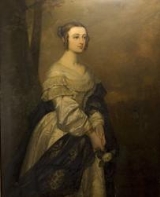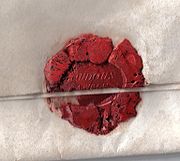
Lady Flora Hastings
Encyclopedia
Lady Flora Elizabeth Rawdon-Hastings (11 February 1806 – 5 July 1839) was a British aristocrat and lady-in-waiting to Queen Victoria
's mother, the Duchess of Kent
, whose death in 1839 caused a court scandal that gave the Queen a negative image.
Flora was also a poet; her work, Poems by the lady Flora Hastings, was published posthumously by her sister Sophia.
(1754-1826) and his wife Flora Mure-Campbell, 6th Countess of Loudoun (1780-1840). Flora's siblings were:
Flora was "adored" by her siblings.
 The unmarried Lady Flora was allegedly having an affair with John Conroy
The unmarried Lady Flora was allegedly having an affair with John Conroy
, the "favourite
" and also suspected lover of the Duchess of Kent. The Duchess's daughter, Queen Victoria, detested Conroy passionately. Flora and the Queen were probably hostile and unfriendly toward one another for this reason, and also because Flora disliked the Queen's adored friend and mentor, Baroness Louise Lehzen, as well as the Prime Minister, Lord Melbourne
.
As the Duchess of Kent's lady in waiting, Hastings was party to Conroy's infamous 'Kensington System' by which the he colluded with the Duchess to keep Victoria isolated from her Hanoverian uncles. She may have been involved in Conroy's pernicious and continued attempts to force Victoria to sign an order of Regency, even during a serious illness. For these reasons, the young Victoria hated and suspected Hastings and was open to any accusation that could be laid at the feet of Conroy or his aides. Once she ascended the throne in June, 1837, Victoria made every attempt to keep her mother's household, including Hastings and Conroy, away from her in distant parts of Buckingham Palace. She could not banish them outright, being an unmarried woman at the time, but she kept her mother, Conroy and all persons associated with them as far away from her person as possible. It was only much later in life, after Conroy's death, that Prince Albert was able to effect a reconciliation between the Duchess of Kent and Victoria.
Sometime in 1839, Flora began to experience pain and swelling in her lower abdomen. She visited the Queen's physician, Sir James Clark, Baronet, who could not diagnose her condition without an examination, which Flora refused. He assumed the abdominal growth was pregnancy. Sir James met with Flora twice a week from January 10 to February 16, 1839. Because Flora was unmarried, his suspicions were hushed up. However, Flora's enemies, Baroness Lehzen and the Marchioness of Tavistock (better known as the inventor of afternoon tea) spread the rumor that she was "with child", and eventually Lehzen told Melbourne about her fears. On February 2, the Queen wrote in her journal that she suspected that Conroy, a man whom she loathed intensely, was the father.
The accusations were proven false when Flora finally consented to the physical examination by the royal doctors, who confirmed that she was not pregnant. She did, however, have an advanced, cancerous liver tumor, and had only months left to live. She died in London on July 5. Conroy and her brother, Lord Hastings, stirred up a press campaign against both the Queen and Doctor Clark which attacked them for insulting and disgracing Flora with false rumors and for plotting against her and the entire Hastings family. The campaign also defamed the Queen's "fellow conspirators", Baroness Lehzen and Lady Tavistock, as the guilty parties who had originated the false rumor of pregnancy. These attempts fell far short of their goals of discrediting the Queen and forcing her to appoint Conroy to some post close to her person. Victoria remained adamant that Conroy should never be close to the throne in any fashion. The next year, her marriage and subsequent pregnancy restored her to popular favour.
in the 2009 film The Young Victoria
.
Victoria of the United Kingdom
Victoria was the monarch of the United Kingdom of Great Britain and Ireland from 20 June 1837 until her death. From 1 May 1876, she used the additional title of Empress of India....
's mother, the Duchess of Kent
Princess Victoria of Saxe-Coburg-Saalfeld
Princess Victoria of Saxe-Coburg-Saalfeld was the mother of Queen Victoria of the United Kingdom.-Early life:...
, whose death in 1839 caused a court scandal that gave the Queen a negative image.
Flora was also a poet; her work, Poems by the lady Flora Hastings, was published posthumously by her sister Sophia.
Family
Lady Flora was born to Francis Rawdon-Hastings, 1st Marquess of HastingsFrancis Rawdon-Hastings, 1st Marquess of Hastings
Francis Edward Rawdon-Hastings, 1st Marquess of Hastings KG PC , styled The Honourable Francis Rawdon from birth until 1762 and as The Lord Rawdon between 1762 and 1783 and known as The Earl of Moira between 1793 and 1816, was an Irish-British politician and military officer who served as...
(1754-1826) and his wife Flora Mure-Campbell, 6th Countess of Loudoun (1780-1840). Flora's siblings were:
- George Augustus Francis Rawdon-Hastings, 2nd Marquess of HastingsGeorge Rawdon-Hastings, 2nd Marquess of HastingsGeorge Augustus Francis Rawdon-Hastings, 2nd Marquess of Hastings , styled Lord Rawdon from birth until 1817 and Earl of Rawdon from 1817 to 1826, was a British peer and courtier.-Background:...
(4 February 1808–13 January 1844) - Sophia Frederica Christina Rawdon-Hastings (1 February 1809–28 December 1859), married John Crichton-Stuart, 2nd Marquess of ButeJohn Crichton-Stuart, 2nd Marquess of ButeJohn Crichton-Stuart, 2nd Marquess of Bute, KT, FRS was the son of John, Lord Mount Stuart and the former Lady Elizabeth McDouall-Crichton...
and had issue - Selina Constance Rawdon-Hastings (1810–8 November 1867), married Charles Henry and had issue
- Adelaide Augusta Lavinia Rawdon-Hastings (25 February 1812–6 December 1860), married Sir William Keith Murray, 7th Baronet of Octertyre
Flora was "adored" by her siblings.
Scandal

John Conroy
Sir John Conroy, 1st Baronet KH was a British army officer who became the chief attendant of the Duke of Kent and the Duchess of Kent who were the parents of Queen Victoria. When the Duke died, he became comptroller of the duchess' household and was rumoured to be her lover...
, the "favourite
Favourite
A favourite , or favorite , was the intimate companion of a ruler or other important person. In medieval and Early Modern Europe, among other times and places, the term is used of individuals delegated significant political power by a ruler...
" and also suspected lover of the Duchess of Kent. The Duchess's daughter, Queen Victoria, detested Conroy passionately. Flora and the Queen were probably hostile and unfriendly toward one another for this reason, and also because Flora disliked the Queen's adored friend and mentor, Baroness Louise Lehzen, as well as the Prime Minister, Lord Melbourne
William Lamb, 2nd Viscount Melbourne
William Lamb, 2nd Viscount Melbourne, PC, FRS was a British Whig statesman who served as Home Secretary and Prime Minister . He is best known for his intense and successful mentoring of Queen Victoria, at ages 18-21, in the ways of politics...
.
As the Duchess of Kent's lady in waiting, Hastings was party to Conroy's infamous 'Kensington System' by which the he colluded with the Duchess to keep Victoria isolated from her Hanoverian uncles. She may have been involved in Conroy's pernicious and continued attempts to force Victoria to sign an order of Regency, even during a serious illness. For these reasons, the young Victoria hated and suspected Hastings and was open to any accusation that could be laid at the feet of Conroy or his aides. Once she ascended the throne in June, 1837, Victoria made every attempt to keep her mother's household, including Hastings and Conroy, away from her in distant parts of Buckingham Palace. She could not banish them outright, being an unmarried woman at the time, but she kept her mother, Conroy and all persons associated with them as far away from her person as possible. It was only much later in life, after Conroy's death, that Prince Albert was able to effect a reconciliation between the Duchess of Kent and Victoria.
Sometime in 1839, Flora began to experience pain and swelling in her lower abdomen. She visited the Queen's physician, Sir James Clark, Baronet, who could not diagnose her condition without an examination, which Flora refused. He assumed the abdominal growth was pregnancy. Sir James met with Flora twice a week from January 10 to February 16, 1839. Because Flora was unmarried, his suspicions were hushed up. However, Flora's enemies, Baroness Lehzen and the Marchioness of Tavistock (better known as the inventor of afternoon tea) spread the rumor that she was "with child", and eventually Lehzen told Melbourne about her fears. On February 2, the Queen wrote in her journal that she suspected that Conroy, a man whom she loathed intensely, was the father.
The accusations were proven false when Flora finally consented to the physical examination by the royal doctors, who confirmed that she was not pregnant. She did, however, have an advanced, cancerous liver tumor, and had only months left to live. She died in London on July 5. Conroy and her brother, Lord Hastings, stirred up a press campaign against both the Queen and Doctor Clark which attacked them for insulting and disgracing Flora with false rumors and for plotting against her and the entire Hastings family. The campaign also defamed the Queen's "fellow conspirators", Baroness Lehzen and Lady Tavistock, as the guilty parties who had originated the false rumor of pregnancy. These attempts fell far short of their goals of discrediting the Queen and forcing her to appoint Conroy to some post close to her person. Victoria remained adamant that Conroy should never be close to the throne in any fashion. The next year, her marriage and subsequent pregnancy restored her to popular favour.
Eglinton Tournament
With only two months to live, Lady Flora wrote in 1839 to her mother on the subject of the upcoming Eglinton Tournament, expressing her concern that one of the knights might be killed in the violent sport.In popular culture
Lady Hastings was portrayed by Irish actress Genevieve O'ReillyGenevieve O'Reilly
Genevieve O'Reilly is an Irish actress who has worked in both the United Kingdom and Australia.-Background:O'Reilly was born in Dublin and raised in Adelaide. She is the eldest of four siblings. At the age of twenty O'Reilly moved to Sydney to attend the National Institute of Dramatic Art,...
in the 2009 film The Young Victoria
The Young Victoria
The Young Victoria is a 2009 period drama film based on the early life and reign of Queen Victoria, and her marriage to Prince Albert of Saxe-Coburg and Gotha. The film was directed by Jean-Marc Vallée and written by screenwriter Julian Fellowes. Graham King, Martin Scorsese, Sarah, Duchess of...
.

